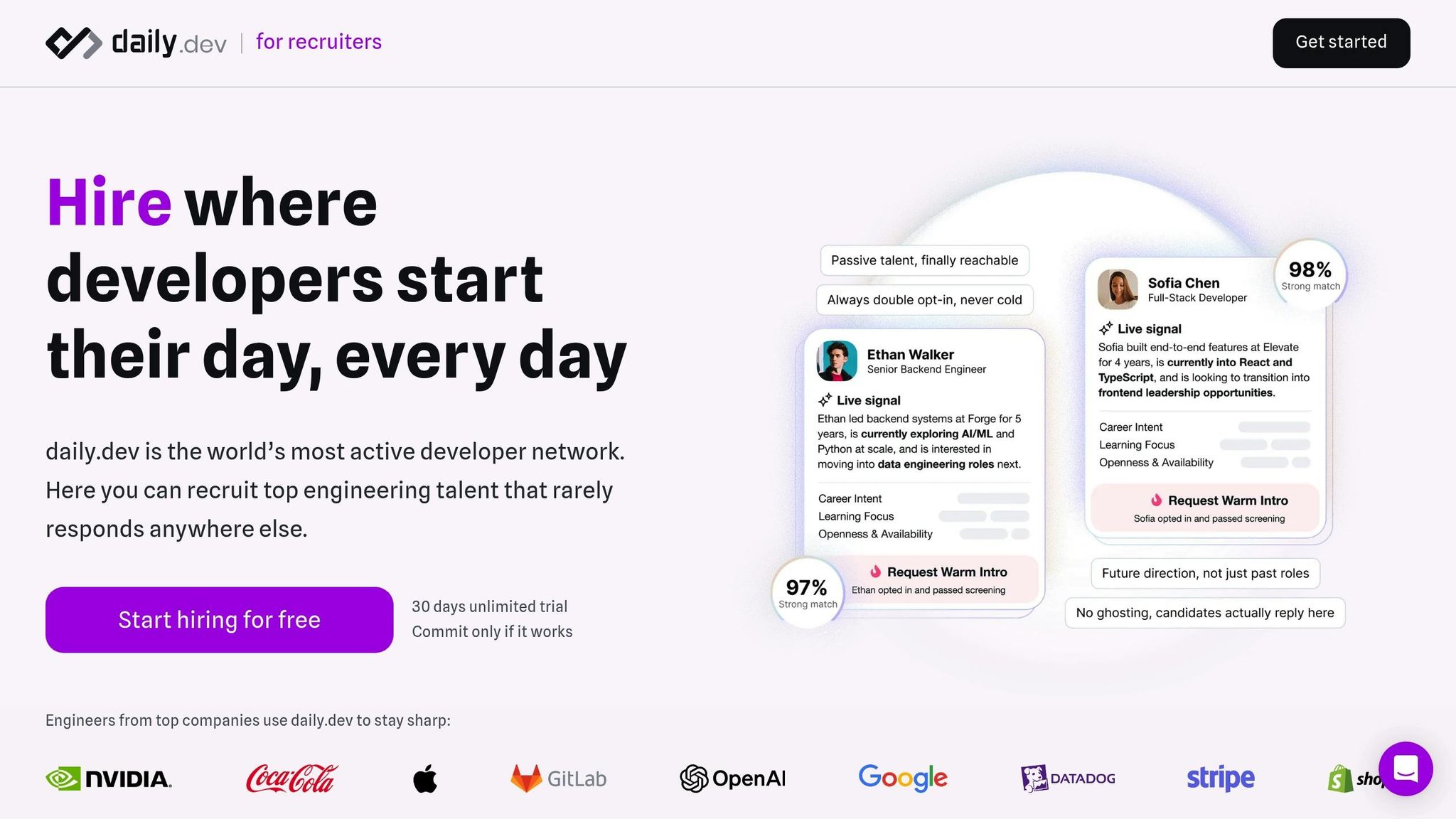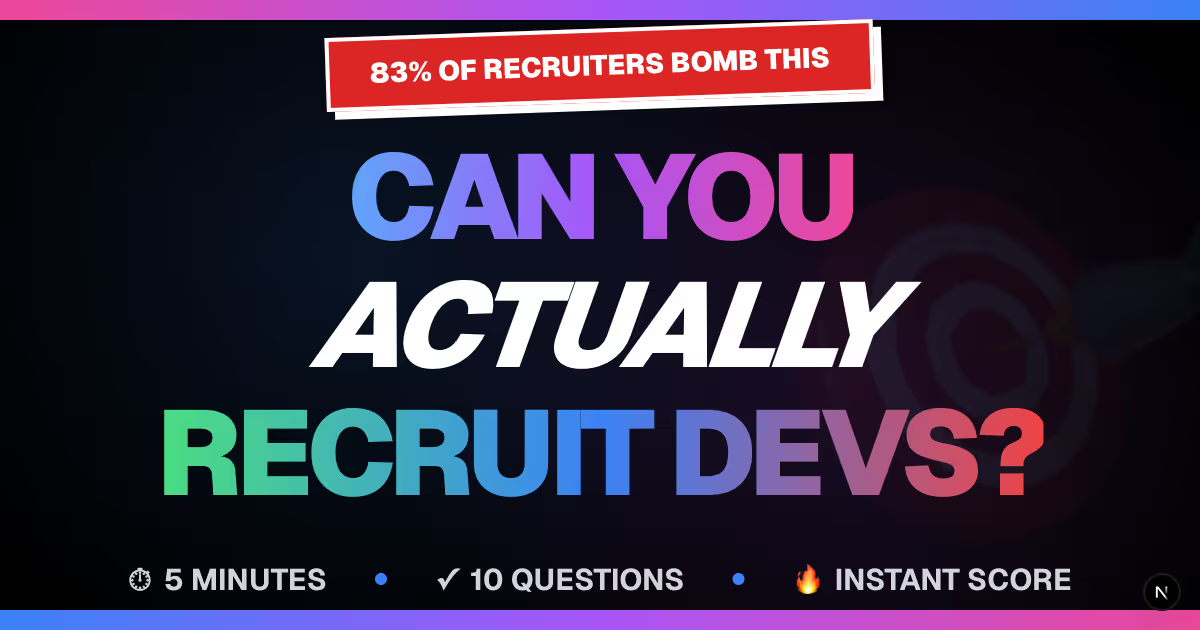


Engage passive developers through personalized outreach, transparency, and relationship building for effective recruiting strategies.
Passive developers - those not actively seeking jobs - make up a hidden talent pool. But 90% of them ignore traditional outreach methods due to impersonal messages and lack of trust. To connect with them effectively, recruiters need a more thoughtful approach. Here's how:
- Personalized Outreach: Tailor your messages to their skills and career goals to build trust.
- Developer-First Platforms: Use tools like daily.dev Recruiter that integrate recruiting into developers' routines, enabling warm, double opt-in introductions with an 85–90% reply rate.
- Transparency: Clearly outline job roles, responsibilities, and challenges to set realistic expectations.
- Relationship Building: Stay connected over time without being pushy, creating a pipeline of engaged candidates.
- Offer Value First: Share useful resources or insights to establish trust before pitching roles.
- Data-Driven Targeting: Leverage AI and data to match candidates with roles based on their skills and interests.
- Respect Preferences: Simplify communication, avoid ghosting, and eliminate vague or irrelevant outreach.
These strategies focus on trust, relevance, and respect, ensuring recruiters connect meaningfully with passive developers. Platforms like daily.dev Recruiter make this process smoother by aligning opportunities with developers’ preferences and skills.
Passive Recruiting Methods That Work
1. Use Personalized Outreach to Build Trust
When it comes to tech recruiting, trust is everything. Traditional cold outreach often misses the mark, especially with passive developers. As Nimrod Kramer from daily.dev aptly states, "Trust is the currency of modern recruiting". Developers today are tired of generic messages or AI-generated outreach that feels impersonal and disconnected from their work. To succeed, recruiters need an approach that genuinely connects with each developer's individual journey.
This means going beyond surface-level details like job titles. Recruiters should take the time to understand a developer’s projects, technical interests, and career goals. Dive into their work history, current focus, and aspirations for the future. By doing this, recruiters can craft outreach that resonates - offering opportunities that align with the developer’s specific skills and ambitions rather than sending out generic job descriptions.
When outreach feels personal and relevant, developers are much more likely to respond. In fact, reply rates for well-matched, double opt-in introductions often exceed 85–90%. That’s a significant improvement over standard cold outreach.
Transparency is just as important. Developers value clear, detailed job descriptions that outline the role, the technical challenges, and how the position ties into their expertise. This level of clarity allows developers to self-assess and engage only when the opportunity truly fits their interests.
Platforms like daily.dev Recruiter are leading the charge in this personalized approach. By enabling warm, double opt-in introductions, the platform ensures that candidates are pre-qualified and that opportunities are tailored to their skills, interests, and career goals. Developers who choose to engage through such systems already have a solid understanding of the role, making the process smoother and more meaningful for everyone involved.
This shift toward personalization is reshaping tech recruiting. It’s no longer about mass outreach but about building trust through thoughtful, tailored conversations that add value for both recruiters and developers.
2. Use Developer-First Networks Like daily.dev Recruiter

If you want to engage developers effectively, you need to meet them where they already are. Developer-first platforms offer a fresh approach, creating a dynamic that's far removed from traditional recruiting methods. These platforms are built with a deep understanding of how developers think, work, and prefer to communicate.
Take daily.dev Recruiter, for example. This platform operates within a thriving professional network where developers regularly interact with technical content. Instead of disrupting their day with unsolicited messages, it weaves recruiting opportunities into their usual workflow. This approach allows recruiters to connect with developers naturally, setting the stage for meaningful, interest-based introductions.
The warm introduction model is a game-changer for recruitment. Rather than bombarding developers with cold emails and hoping for a response, recruiters get to engage with individuals who have already reviewed the job opportunity and shown interest. As daily.dev Recruiter puts it:
"Every intro comes from a developer who reviewed your role and chose to engage - not someone you had to chase."
This approach works. Double opt-in introductions on daily.dev Recruiter see reply rates soar to 85–90%, even reaching developers who typically ignore outreach on other platforms.
At the heart of this process is the double opt-in system, which puts developers in control. They can explore opportunities tailored to their skills and interests and decide whether to engage. This eliminates irrelevant outreach and ensures that every interaction starts with genuine enthusiasm from both sides.
Trust plays a pivotal role here. Developers are naturally cautious about recruiting messages, having received countless generic pitches and mismatched roles. But when they already trust the platform they’re using, that trust extends to the companies and roles presented there. As daily.dev Recruiter proudly states:
"The only recruiting platform built on developer trust"
This trust-driven approach flips the script on traditional recruiting. Instead of noisy, impersonal outreach, developer-first platforms like daily.dev Recruiter create a system where recruiters connect with engaged, interested candidates who are genuinely ready to discuss their next career move. It’s a smarter, more respectful way to recruit.
3. Show Your Real Company Culture
Developers can easily recognize when a company’s culture doesn’t align with reality. They’ve encountered job descriptions that promise "cutting-edge technology" and "collaborative environments", only to find outdated systems and difficult workplaces. Being honest and upfront always wins over flashy marketing language.
Start by being transparent. Instead of tossing around vague terms like "innovative culture", give specifics. Share details about your tech stack, development workflows, team dynamics, and the mix of legacy and modern tools in use. This kind of openness paves the way for genuine conversations about challenges and opportunities.
Speaking of challenges, don’t shy away from them. Developers respect companies that admit to their struggles - whether it’s dealing with an outdated deployment process or transitioning from an older framework - and explain the steps they’re taking to address them. Being upfront about these realities builds trust far more effectively than presenting an overly polished, unrealistic image.
Make sure to clearly outline the role’s responsibilities. Developers want to know exactly what they’ll be doing day-to-day. Will they focus on building new features, maintaining existing systems, or both? Are there on-call responsibilities? What does career progression look like in your company? These are the details that matter.
Custom screening questions can also help you avoid mismatches. Ask about proficiency with specific frameworks, comfort working with legacy code, or interest in mentoring. This ensures you’re aligned with candidates from the start.
Highlight how your company supports growth. Skilled developers value opportunities to learn and stay on top of new technologies. If you offer perks like conference budgets, learning stipends, or time set aside for experimenting with new tools, make those known. If senior team members share their expertise through tech talks or mentoring programs, mention that too. These initiatives show that you’re invested in their development and reinforce the trust you’ve built with your honest approach.
Finally, eliminate unnecessary frustrations by being specific in your job postings. Don’t just list a generic "full-stack developer" role. Instead, detail the technologies involved, the size of the team, and the scope of the projects. If the position is tied to a defined project timeline, say so. If it’s a long-term role with growth opportunities, make that clear as well.
Your company culture should shine through in how you communicate, not just in what you write. Developers notice when recruiters truly understand their work and speak their language. Providing clear, comprehensive information upfront shows respect for their time and expertise.
4. Build Long-Term Relationships
The best hires often come from relationships that were nurtured long before a job opening even existed. Many developers, especially those who aren't actively job hunting, might not be ready to switch roles immediately - but that doesn’t mean they won’t consider opportunities in the future. The key is to stay connected in a way that feels natural and respectful, without coming across as pushy. This creates a foundation for meaningful, future-focused interactions.
Developers can quickly tell if your outreach is just about collecting names for a database or if you're genuinely interested in their growth and goals. The most effective way to build lasting connections is by meeting developers where they already spend their time - on platforms that they use to learn, keep up with tech trends, and network with peers.
Pay attention to what they’re interested in, the technologies they’re exploring, and their career goals. These details provide valuable insights that can guide personalized outreach down the line. When communication is tailored and relevant, it feels less like a pitch and more like a conversation.
When developers take the initiative to engage, they’re already showing interest. Platforms like daily.dev Recruiter make this process seamless by letting developers reach out first. As the platform explains:
"Every intro comes from a developer who reviewed your role and chose to engage - not someone you had to chase".
This approach removes the discomfort of cold outreach. In early trials, reply rates for double opt-in introductions have consistently hit an impressive 85–90%.
A sustainable relationship-building strategy also means offering value to developers over time. Instead of interrupting them with periodic check-ins, focus on contributing to their professional development through trusted platforms and communities. This not only builds goodwill but also keeps your company in their minds for when they’re ready to make a career move.
While this kind of relationship-building requires patience, the rewards are well worth it. You’ll cultivate a pipeline of pre-qualified candidates who are already familiar with your company and genuinely interested in what you have to offer. When the time comes to fill a position, you won’t need to start from scratch with cold outreach.
sbb-itb-d1e6221
5. Offer Value Before Asking for Anything
Recruiting isn’t just about filling positions - it’s about building trust first. The best recruiters know that trust isn’t something you demand; it’s something you earn. Instead of jumping straight into pitching a role, focus on becoming a valuable resource for a developer’s professional growth. Share insights, provide useful tools, or make meaningful connections that help them grow. This approach sets you apart in a sea of recruiters.
Developers are constantly looking for ways to stay ahead - whether it’s mastering new tools, exploring emerging frameworks, or staying updated on industry trends. You can support this journey by sharing content that truly resonates. Skip the generic reports and instead offer technical articles, updates on cutting-edge technologies, or even introductions to like-minded professionals. By doing this, you’re not just another recruiter; you’re someone who genuinely adds value to their career.
The platform matters too. Developers are more likely to engage on platforms they already trust for professional development. By consistently providing value through these channels, you not only earn their trust but also position yourself as someone they’ll turn to when they’re ready for new opportunities.
This value-driven approach does more than just open doors - it fosters long-term engagement. Over time, you’ll naturally connect with developers who are passionate about growth and learning, the kind of candidates companies are eager to hire. And when the time comes to present an opportunity, they’ll already see you as a trusted partner, not just another recruiter.
6. Use Data and AI for Better Targeting
Gone are the days of generic outreach. With data-driven insights and AI, you can pinpoint developers who are genuinely interested in the roles you’re offering. Personalized outreach builds trust, and this same principle applies when data and AI are used to fine-tune candidate matching. It’s about connecting the right people with the right opportunities.
To do this effectively, go beyond just looking at a static resume. Consider a developer’s current skills, interests, career goals, work history, seniority level, preferred technologies, programming languages, and even geographic location. This well-rounded approach helps you align job opportunities with each candidate’s unique profile.
One proven method to enhance response rates is double opt-in introductions. This means developers review the role and agree to engage before any conversation begins. It’s a system that fosters trust and significantly boosts engagement.
"Because they choose to. Every introduction is double opt-in, which means the developer has already reviewed the role and agreed to the conversation. In early cohorts, reply rates consistently exceed 85–90%."
- daily.dev Recruiter
The most effective platforms rely on active developer engagement rather than scraped profiles. When developers voluntarily interact with content, share their interests, or engage with professional development resources, they send authentic signals about their career direction. These signals help build trust while improving targeting accuracy.
For precision targeting, focus on the specific criteria essential to the role. Define clear requirements - such as seniority, technologies, programming languages, and location preferences - and use platforms that screen candidates against these criteria before making introductions. This ensures you’re only reaching out to those who truly match the role.
Additionally, integrating with an Applicant Tracking System (ATS) can streamline the recruiting process. Tools that sync with your ATS can offer features like candidate deduplication, preventing redundant outreach and saving time.
"Your opportunity is discreetly shown only to developers who fit the role, based on their skills, current interests and career goals."
- daily.dev Recruiter
To further refine your targeting, create detailed job descriptions that translate into developer-friendly briefs. Add custom screening questions to capture specific requirements, ensuring AI can effectively match opportunities with interested candidates. Avoid relying on generic AI automation that sends irrelevant opportunities - it can overwhelm candidates and damage trust. Instead, focus on creating meaningful, targeted connections.
7. Respect Developer Preferences and Keep It Simple
When it comes to recruiting developers, respecting their preferences isn't just polite - it's essential. Poor communication, outdated practices, and a lack of transparency can quickly lead to frustration and disengagement.
"We asked developers what's broken in hiring. Their answers: trivia interviews, ghosting, vague roles, fake jobs, and AI noise. Here's how to fix it (for real)." - Nimrod Kramer, daily.dev
This feedback highlights the need for a more thoughtful and respectful hiring process. By focusing on personalized outreach and clear communication, you can create a better experience for developers. Here are some ways to make that happen:
- Let developers take the lead. Give them the chance to review opportunities and decide how they’d like to engage. A double opt-in approach ensures conversations start with genuine interest from both sides.
- Be transparent about the role. Share detailed information about the position, including the tech stack, team culture, and expectations. This helps developers quickly determine if the role aligns with their skills and goals.
- Simplify communication. Keep your messages clear and to the point. Respecting their time means cutting through the noise and focusing on what matters most.
- Eliminate common frustrations. Avoid ghosting, vague job descriptions, and impersonal AI-generated outreach. Make sure your job postings are authentic and tailored to the audience you're trying to reach.
- Engage developers where they already are. Platforms like daily.dev are trusted spaces where developers stay updated on tools and trends. As one daily.dev source explains:
"Developers come to daily.dev every day to stay sharp on tools, technologies, and trends. And they trust this environment far more than traditional social media platforms - which is why they actually reply here." - daily.dev
- Refine your screening process. Use specific criteria for initial screenings to ensure you’re focusing on candidates who are truly a good fit. This saves time for both the recruiter and the developer.
Comparison Table
When deciding between traditional recruitment methods and developer-first platforms, the contrast in performance and candidate experience is striking. Developer-first platforms, like daily.dev Recruiter, focus on meaningful engagement at every step, reshaping how recruiting connects with talent.
| Metric | Traditional Recruitment Methods | daily.dev Recruiter |
|---|---|---|
| Reply Rates | Low engagement, especially with passive talent | 85–90% reply rates in early cohorts |
| Developer Response | 90% of developers in the daily.dev network won't reply to outreach | High engagement through warm, double opt-in introductions |
| Trust Building | Cold outreach and static databases that developers distrust | Built on existing developer trust within the daily.dev platform |
| Outreach Method | Cold emails and mass messaging | Warm, double opt-in introductions only |
| Candidate Experience | Vague roles, ghosting, trivia interviews, AI noise | Full context provided upfront with transparent opportunities |
| Targeting | Broad, untargeted outreach | Discreet matching based on skills, interests, and career goals |
| Developer Control | Limited transparency and candidate control | Developers choose to engage after reviewing complete role details |
| Screening Efficiency | Extensive screening due to low initial qualification | Pre-qualified candidates reduce unnecessary screening |
Traditional recruitment methods face challenges like low response rates and lack of trust, making it harder to connect with top talent. In contrast, daily.dev Recruiter thrives by engaging developers within a trusted environment. By leveraging metrics like reply rates and targeted matching, this platform ensures every interaction is relevant and valuable.
Conclusion
Building strong developer engagement hinges on three key elements: trust, personalized outreach, and mutual respect. The strategies shared here emphasize moving away from impersonal cold outreach and focusing on creating meaningful connections that benefit both recruiters and developers.
Using personalized, double opt-in introductions removes the uncertainty of cold outreach and encourages authentic interactions. In fact, trusted, developer-focused outreach can achieve reply rates as high as 85–90%. These figures highlight the importance of trust, especially as traditional recruiting methods have often damaged candidate relationships.
When recruiters align opportunities with developers' skills and career aspirations, engagement naturally improves. Platforms like daily.dev Recruiter embody this shift toward developer-first recruiting. Rather than relying on outdated profiles or mass emails, these tools connect recruiters with active, engaged developers in real time. With 1 in 50 developers worldwide on daily.dev and 40% of its users being senior contributors or leaders, this platform provides access to highly skilled talent that traditional methods often miss.
For recruiters seeking to modernize their approach, the solution is straightforward: offer value from the start, honor developers' preferences, and use tools designed specifically for developers by developers.
The future of developer recruiting isn’t about increasing the volume of emails or calls. It’s about fostering trust-driven relationships where every interaction is meaningful and every introduction is intentional. By respecting how developers prefer to be approached, recruiters can achieve results that truly stand out.
FAQs
What are the best ways for recruiters to build trust with passive developers who aren’t actively job hunting?
To earn the trust of passive developers, it’s important to approach them with respect and a personal touch. Share opportunities that align closely with their skills and career aspirations, making each interaction feel thoughtful and relevant. Be upfront and clear in your communication - transparency goes a long way in building meaningful relationships. Consider using a double opt-in process, where developers can review and decide if they’re interested in engaging with a role before committing to a conversation. This not only respects their time but also reinforces a sense of mutual understanding and trust.
How do developer-first platforms like daily.dev Recruiter help recruiters connect with passive developers?
Platforms like daily.dev Recruiter are designed to help recruiters connect with developers in a way that feels natural and relevant. These platforms focus on meeting developers where they already spend their time - whether that's exploring tools, catching up on industry news, or expanding their skills. By creating a developer-centric space, they establish an environment built on trust and authenticity.
What sets daily.dev Recruiter apart is its emphasis on high-context interactions. Recruiters can engage with developers who are already pre-qualified and more likely to respond. This approach leads to much better engagement compared to traditional cold outreach, as developers only interact with opportunities they find credible and worthwhile.
Why should recruiters share clear and detailed job descriptions when reaching out to developers?
Providing well-thought-out job descriptions is crucial for helping developers grasp the role, its responsibilities, and how it fits with their skill set and career aspirations. Clear communication from the outset builds trust and ensures everyone is on the same page regarding expectations.
When recruiters include details like necessary skills, team structure, and potential for growth, they’re more likely to draw in candidates who are both qualified and genuinely interested. This not only streamlines the hiring process but also creates a smoother, more positive experience for both developers and recruiters.
Related Blog Posts








